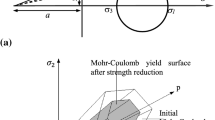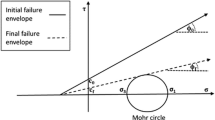Abstract
For geotechnical stability analysis involving the Drucker-Prager (DP) criterion, both the c-φ reduction scheme and the M-K reduction scheme can be utilized. With the aid of the second-order cone programming optimized finite element method (FEM-SOCP), a comparison of the two strength reduction schemes for the stability analysis of a homogeneous slope and a multilayered slope is carried out. Numerical investigations disclose that the FoS results calculated by the c-φ reduction scheme agree well with those calculated by the classical Morgenstern-Price solutions. However, the FoS results attained by the M-K reduction scheme may lead to conservative estimation of the geotechnical safety, particularly for the cases with large internal friction angles. In view of the possible big difference in stability analysis results caused by the M-K reduction scheme, the c-φ reduction scheme is recommended for the geotechnical stability analyses involving the DP criterion.
摘要
对于涉及Drucker-Prager准则的岩土体稳定性分析, 可以使用c-φ折减方案和M-K折减方案. 基 于二阶锥规划有限元法, 对均质土边坡和多层土边坡稳定性分析中的两种强度折减方案进行了对比. 研究表明, 基于c-φ 折减方案得到的安全系数与Morgenstern-Price 法计算获得的结果吻合较好. 然而, 基于M-K折减方案得到的安全系数结果可能导致对岩土体安全性的保守估计, 特别是对于大内摩擦角 的情况. 考虑到M-K折减方案在稳定性分析结果上可能会造成较大差异, 对于涉及Drucker-Prager 准 则的岩土体稳定性分析建议采用c-φ 折减方案.
Similar content being viewed by others
References
ZIENKIEWICZ O C, HUMPHESON C, LEWIS R W. Associated and non-associated visco-plasticity and plasticity in soil mechanics [J]. Géotechnique, 1975, 25(4): 671–689. DOI:https://doi.org/10.1680/geot.1975.25.4.671.
GRIFFITHS D V, LANE P A. Slope stability analysis by finite elements [J]. Géotechnique, 1999, 49(3): 387–403. DOI:https://doi.org/10.1680/geot.1999.49.3.387.
GUROCAK Z, ALEMDAG S, ZAMAN M M. Rock slope stability and excavatability assessment of rocks at the Kapikaya dam site, Turkey [J]. Engineering Geology, 2008, 96(1, 2): 17–27. DOI:https://doi.org/10.1016/j.enggeo.2007.08.005.
HUANG Fu, ZHANG Dao-bing, SUN Zhi-bin, JIN Qi-yun. Upper bound solutions of stability factor of shallow tunnels in saturated soil based on strength reduction technique [J]. Journal of Central South University, 2012, 19(7): 2008–2015. DOI:https://doi.org/10.1007/s11771-012-1238-4.
SLOAN S W. Geotechnical stability analysis [J]. Géotechnique, 2013, 63(7): 531–571. DOI:https://doi.org/10.1680/geot.12.RL.001.
YUAN Wei, BAI Bing, LI Xiao-chun, WANG Hai-bin. A strength reduction method based on double reduction parameters and its application [J]. Journal of Central South University, 2013, 20(9): 2555–2562. DOI:https://doi.org/10.1007/s11771-013-1768-4.
KAYA A, ALEMDAĞ S, DAĞ S, GÜROCAK Z. Stability assessment of high-steep cut slope debris on a landslide (Gumushane, NE Turkey) [J]. Bulletin of Engineering Geology and the Environment, 2016, 75(1): 89–99. DOI:https://doi.org/10.1007/s10064-015-0753-6.
GUO Shuang-feng, LI Ning, LIU Chun, LIU Nai-fei. Unraveling the progressive failure behaviors and mechanisms of the slope with a local dynamic method based on the double strength reduction [J]. International Journal of Geomechanics, 2020, 20(6): 04020069. DOI:https://doi.org/10.1061/(ASCE)GM.1943-5622.0001693.
SUN Chao-wei, CHAI Jun-rui, LUO Tao, XU Zeng-guang. Nonlinear shear-strength reduction technique for stability analysis of uniform cohesive slopes with a general nonlinear failure criterion [J]. International Journal of Geomechanics, 2021, 21(1): 06020033. DOI:https://doi.org/10.1061/(ASCE)GM.1943-5622.0001885.
CHEN Xi, WU Yong-kang, YU Yu-zhen, LIU Jian-kun, XU X F, REN Jun. A two-grid search scheme for large-scale 3-D finite element analyses of slope stability [J]. Computers and Geotechnics, 2014, 62: 203–215. DOI:https://doi.org/10.1016/j.compgeo.2014.07.010.
ALEMDAĞ S, KAYA A, KARADAĞ M, GÜROCAK Z, BULUT F. Utilization of the limit equilibrium and finite element methods for the stability analysis of the slope debris: an example of the Kalebasi district (NE Turkey) [J]. Journal of African Earth Sciences, 2015, 106: 134–146. DOI:https://doi.org/10.1016/j.jafrearsci.2015.03.010.
ZHANG Xue, SHENG Dai-chao, SLOAN S W, BLEYER J. Lagrangian modelling of large deformation induced by progressive failure of sensitive clays with elastoviscoplasticity [J]. International Journal for Numerical Methods in Engineering, 2017, 112(8): 963–989. DOI:https://doi.org/10.1002/nme.5539.
MENG Jing-jing, ZHANG Xue, HUANG Jin-song, TANG Hong-xiang, MATTSSON H, LAUE J. A smoothed finite element method using second-order cone programming [J]. Computers and Geotechnics, 2020, 123: 103547. DOI:https://doi.org/10.1016/j.compgeo.2020.103547.
CHEN Xi, WANG Dong-yong, TANG Jian-bin, MA Wen-chen, LIU Yong. Geotechnical stability analysis considering strain softening using micro-polar continuum finite element method [J]. Journal of Central South University, 2021, 28(1): 297–310. DOI:https://doi.org/10.1007/s11771-021-4603-3.
ABBO A J, SLOAN S W. A smooth hyperbolic approximation to the Mohr-Coulomb yield criterion [J]. Computers and Structures, 1995, 54(3): 427–441. DOI:https://doi.org/10.1016/0045-7949(94)00339-5.
CHEN Xi, WANG Dong-yong, YU Yu-zhen, LV Yan-nan. A modified Davis approach for geotechnical stability analysis involving non-associated soil plasticity [J]. Géotechnique, 2020, 70(12): 1109–1119. DOI:https://doi.org/10.1680/jgeot.18.p.158.
CAMARGO J, VELLOSO R Q, VARGAS E A. Numerical limit analysis of three-dimensional slope stability problems in catchment areas [J]. Acta Geotechnica, 2016, 11(6): 1369–1383. DOI:https://doi.org/10.1007/s11440-016-0459-3.
KRABBENHØFT K. OptumG2: materials. Optum computational engineering [OB/OL]. [2020-12-01] http://www.optumce.com.
DRUCKER D C, PRAGER W. Soil mechanics and plastic analysis or limit design [J]. Quarterly of Applied Mathematics, 1952, 10(2): 157–165.
ALEJANO L R, BOBET A. Drucker — Prager criterion [J]. Rock Mechanics and Rock Engineering, 2012, 45: 995–999. DOI:https://doi.org/10.1007/s00603-012-0278-2.
KRABBENHØFT K, KARIM M R, LYAMIN A V, SLOAN S W. Associated computational plasticity schemes for nonassociated frictional materials [J]. International Journal for Numerical Methods in Engineering, 2012, 90(9): 1089–1117. DOI:https://doi.org/10.1002/nme.3358.
VERMEER P A, DE BORST R. Non-associated plasticity for soils, concrete and rock [J]. Heron, 1984, 29 (3): 1–64.
WANG Dong-yong, CHEN Xi, YU Yu-zhen, JIE Yu-xin, LV Yan-nan. Stability and deformation analysis for geotechnical problems with nonassociated plasticity based on second-order cone programming [J]. International Journal of Geomechanics, 2019, 19(2): 04018190. DOI:https://doi.org/10.1061/(ASCE)GM.1943-5622.0001339.
CHENG Y M, LANSIVAARA T, WEI W B. Two-dimensional slope stability analysis by limit equilibrium and strength reduction methods [J]. Computers and Geotechnics, 2007, 34(3): 137–150. DOI:https://doi.org/10.1016/j.compgeo.2006.10.011.
DONALD I B, GIAM P. The ACADS slope stability programs review [C]// Landslides: Proceedings of the 6th International Aymposium, 1992, 3: 1665–1670.
Author information
Authors and Affiliations
Corresponding author
Additional information
Foundation item
Projects(42002277, 41972279, 41772291) supported by the National Natural Science Foundation of China; Projects (2020M680321, 2021T140046) supported by the China Postdoctoral Science Foundation; Projects(2020-zz-081, 2021-PC-003) supported by the Beijing Postdoctoral Research Foundation, China; Project(X21074) supported by the Fundamental Research Funds for Beijing University of Civil Engineering and Architecture, China
Contributors
WANG Dong-yong performed some analyses and wrote the first draft; CHEN Xi provided the concept and edited the manuscript; QI Ji-lin gave some revision suggestions on the first draft; PENG Li-yun edited the final revised draft.
Conflict of interest
WANG Dong-yong, CHEN Xi, QI Ji-lin and Peng Li-yun declare that they have no conflict of interest.
Rights and permissions
About this article
Cite this article
Wang, Dy., Chen, X., Qi, Jl. et al. Assessment on strength reduction schemes for geotechnical stability analysis involving the Drucker-Prager criterion. J. Cent. South Univ. 28, 3238–3245 (2021). https://doi.org/10.1007/s11771-021-4828-1
Received:
Accepted:
Published:
Issue Date:
DOI: https://doi.org/10.1007/s11771-021-4828-1
Key words
- geotechnical stability
- Drucker-Prager criterion
- strength reduction
- second-order cone programming
- c-φ reduction
- M-K reduction




